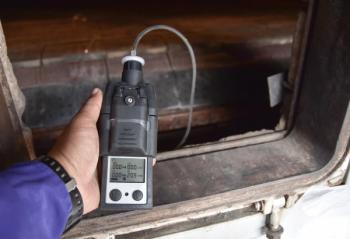
Best of the Week: Monitoring Arsenic in Water, Studying Interstellar Objects, Changes to USP Chapters 41 and 1251
Key Takeaways
- A fully automated system for arsenic monitoring in natural waters offers precise, real-time detection with low detection limits, enhancing environmental monitoring capabilities.
- Potassium bromide glasses facilitate high-resolution spectra under extreme conditions, improving exoplanet characterization and aiding in the interpretation of JWST data.
Top articles published this week include a news article about monitoring arsenic in natural waters, an inside look at spectroscopic observations of interstellar objects, and an interview that highlights changes made to USP Chapters 41 and 1251.
This week, Spectroscopy published a variety of articles highlighting recent studies in several application areas, including environmental analysis and astronomy. Key techniques highlighted in these articles include infrared (IR) spectroscopy and atomic fluorescence spectroscopy (AFS). Happy reading!
A recent study published in the journal Talanta presented a newly developed fully automated system for the continuous monitoring of total dissolved inorganic arsenic (TDIAs) in natural waters (1). This study introduces the flow injection–hydride generation–atomic fluorescence spectroscopy (FI-HG-AFS) system, which integrates advanced modules for precise, on-site, real-time detection (1). The system achieved detection limits as low as 0.005 μg/L with high accuracy across varied water samples. Field trials confirmed its reliability, marking a breakthrough in environmental monitoring that enables rapid response to arsenic contamination threats.
A recent study published in Research Notes of the AAS highlighted the use of potassium bromide (KBr) glasses in simulating exoplanetary conditions. KBr glasses, which have long been used in IR spectroscopy, can encapsulate complex molecules like polycyclic aromatic hydrocarbons, enabling high-resolution spectra under extreme pressure and temperature conditions (2). These laboratory-generated reference spectra aid in interpreting James Webb Space Telescope (JWST) data, reducing challenges from overlapping signals (2). Although KBr glasses cannot replicate atmospheric or gas-phase dynamics, expanding molecular spectral databases could significantly improve exoplanet characterization and astrobiological investigations.
Astronomers have conducted the first detailed spectroscopic observations of the interstellar object 3I/ATLAS (C/2025 N1), discovered on July 1, 2025, by the ATLAS survey telescope in Chile (3). Using the Goodman High Throughput Spectrograph on the SOAR Telescope, researchers recorded a steep red reflectance spectrum consistent with carbon-rich, irradiated organics, but detected no volatile gas emissions despite a visible dust coma (3). Thermal modeling suggests that water ice remains buried beneath the surface, with dust release likely driven by non-sublimation processes. As 3I nears its October 2025 perihelion, continued monitoring may reveal new insights into extrasolar material composition (3).
Astronomers recently conducted detailed spectrophotometric observations of 3I/ATLAS, the third confirmed interstellar object, using the Palomar 200-inch telescope and Apache Point Observatory. Discovered on July 1, 2025, 3I/ATLAS follows a hyperbolic orbit, confirming its extrasolar origin (4). Data revealed a distinctly red spectral slope, redder than most solar system comets, with no detectable gas emissions such as C2 or CO+, suggesting limited volatile activity at 4.3 au from the Sun (4). Despite this, surface brightness profiles indicate ongoing dust activity. These findings highlight 3I/ATLAS’s unique composition and behavior, with future observations around its October 2025 perihelion expected to yield further insights.
As part of our coverage of Analytica USA, Spectroscopy interviewed Ian Ciesniewski, technical director at Mettler Toledo, about the recent updates to USP Chapters 41 and 1251. Although Chapter 41 remains auditable, Chapter 1251 serves as an informational guide to optimize analytical balance performance. The revised Chapter 1251 clarifies long-standing concepts, such as applying safety factors when determining minimum weight and ensuring net sample weights exceed calculated thresholds (5). It also emphasizes monitoring balance performance over time and introduces flexibility in balance check frequency, allowing labs to tailor testing schedules (5). These changes aim to improve weighing practices, enhance accuracy, and support better laboratory efficiency.
References
- Wetzel, W. Real-Time Monitoring of Arsenic in Natural Waters. Spectroscopy. Available at:
https://www.spectroscopyonline.com/view/real-time-monitoring-of-arsenic-in-natural-waters (accessed 2025-10-02). - Wetzel, W. Advancing Laboratory-Based Simulations of Exoplanetary Conditions with KBr Glasses. Spectroscopy. Available at:
https://www.spectroscopyonline.com/view/advancing-laboratory-based-simulations-of-exoplanetary-conditions-with-kbr-glasses (accessed 2025-10-02). - Workman, Jr., J. The Red Visitor from Beyond: Unlocking the Secrets of Interstellar Object 3I/ATLAS. Spectroscopy. Available at:
https://www.spectroscopyonline.com/view/the-red-visitor-from-beyond-unlocking-the-secrets-of-interstellar-object-3i-atlas (accessed 2025-10-02). - Workman, Jr., J. Interstellar Comet 3I/ATLAS Shows Its Spectral Secrets Through Palomar and Apache Point Observations. Spectroscopy. Available at:
https://www.spectroscopyonline.com/view/interstellar-comet-3i-atlas-shows-its-spectral-secrets-through-palomar-and-apache-point-observations (accessed 2025-10-02). - Wetzel, W. USP Chapters 41 and 1251 Revised: What Analysts Need to Know. Spectroscopy. Available at:
https://www.spectroscopyonline.com/view/usp-chapters-41-and-1251-revised-what-analysts-need-to-know (accessed 2025-10-02).
Newsletter
Get essential updates on the latest spectroscopy technologies, regulatory standards, and best practices—subscribe today to Spectroscopy.





